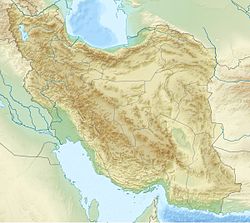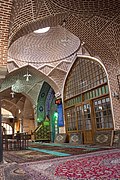Top Qs
Timeline
Chat
Perspective
Saheb-ol-Amr Mosque
Mosque in Tabriz, Iran From Wikipedia, the free encyclopedia
Remove ads
The Sāheb ol Amr Mosque (Persian: مسجد صاحب الامر, romanized: Masjid-e Sāheb ol Amr; Arabic: مسجد صاحب الأمر), also known as the Shah Tahmasp Mosque,[2] is a Shi'ite mosque, located on the east side of Saaheb Aabaad square in Tabriz, East Azerbaijan province, Iran. The mosque was rebuilt in 1636 CE and has a history of destruction and repair. The name Sāheb ol Amr (Master of command) is one of the titles of the last Twelver Shī‘ah Imām.[3]
The mosque was added to the Iran National Heritage List on 2 October 2001, administered by the Cultural Heritage, Handicrafts and Tourism Organization of Iran.
Remove ads
History
The mosque is said to have been built by the Safavid shah Tahmasp I (r.1524-1576), and that it was the first mosque of his reign. The mosque is sometimes known as the Shah Tahmasb Mosque.[4]
Not long after its construction, the building was destroyed by the Ottoman ruler Murad IV after he invaded Tabriz in 1638. Once Iranian troops re-affirmed control over the city, the mosque was rebuilt but suffered great damage from an earthquake that struck the city soon after. Consequently, the entire square along with the mosque was reconstructed and this task was carried out by Goli Khan Danbali.[1] In favour of the people, the mosque was dubbed Sāheb ol Amr, a title of the last Twelver Shī‘ah Imām, Muhammad al-Mahdi.[3] In the 1673 map of Tabriz by Jean Chardin, the mosque appears under the name Saheb Saman and the explanation "Mosque of the last true Calif".[5]
The school yard was destroyed during the expansion of Daraiee Street by the city of Tabriz and only a part of school is now retained.
In ancient times, the Temple of Mithraism was located on this site. The building currently houses a mosque and a Quran museum.[1] The mosque underwent extensive restoration during the 1990s.[4]
Remove ads
Gallery
- Saheb Saman Mosque (E on the map), by Jean Chardin (1673).[2]
- luustration by Eugène Flandin, 1840
- Entrance Iwan
- Interior view
- The mosque at night
- View from the street
- The mosque at night
See also
Notes
- Since rebuilt
References
External links
Wikiwand - on
Seamless Wikipedia browsing. On steroids.
Remove ads









